When I was first approached to come up with this special collection of recipes, I could pretty much hear the readers’ letters writing themselves. “Easy Ottolenghi?” the cry would go. “Isn’t that some sort of culinary oxymoron, like jumbo shrimps and paper tablecloths?” But a story always has two sides. While I’ve never felt the need to defend, or dumb down, the ingredients in my kitchen cupboards, it can be tough to break free from the mould once it has been cast. People approach different food writers with different expectations, and in my case, whenever I produce something that’s super-straightforward and twist-free, I often feel I’m somehow letting my readers down.
I’m neither making the case for sympathy nor mounting any sort of defence. Instead, I’m just offering my own take on quick and easy dishes. Sure, they still feature a few ingredients that may cause some eyes to roll, but I’ve suggested substitutes for all of them. And anyway, there’s more than enough here, I hope, to keep things simple. Fish suppers that are on the table inside 15 minutes, plus a host of vegetable dishes that are ready in 10. A pie that can be put together well in advance, ready to be baked when needed. A tart that uses tinned fruit (yes, really). Recipes where, beyond the chopping and basic prep, the oven does all the work. This is the kind of food I make to put a spring in my step – my own simple twists on everyday winners.
Choy sum with oyster sauce, garlic and peanuts
I’d quite happily have just this and a bowl of rice for dinner any day. It’s all about the crunch and colour of the greens – you want them fresh and vibrant – so take care not to overcook them. Serves four.
3 tbsp groundnut oil
3 garlic cloves, peeled and finely sliced
3cm piece ginger, peeled and cut into thin julienne strips
3 thin strips orange skin (with no bitter white pith)
20g salted roasted peanuts, roughly chopped
550g choy sum, stalks and leaves separated, stalks cut into 5cm pieces, the leaves kept as whole as possible
1½ tbsp oyster sauce
2 tsp light soy sauce
Heat the oil in a small saucepan on a medium-high flame, then fry the garlic, ginger, orange skin and peanuts for two to three minutes, stirring, until the garlic and nuts are a light golden-brown. Tip into a small bowl to stop it cooking, and put the pan aside until later.
Half-fill a large saucepan with a steamer attachment with water – just enough so it doesn’t touch the base of the steaming basket. Bring to a boil, steam all the choy sum for 90 seconds, then transfer to a plate.
Return the peanut pan to a high heat – don’t worry about wiping it clean – and warm through the oyster and soy sauces for just 10-15 seconds, then pour over the choy sum. Sprinkle the peanut mix and two tablespoons of the oil on top, and serve at once.
Roast leeks and soya beans with buffalo mozzarella
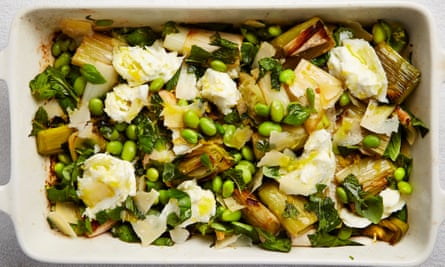
One of the many great things about soya beans (aka edamame) is that you can buy them ready shelled and frozen, so they keep that natural, vibrant green colour. They’re a bit like podded broad beans, but without all the extra work involved in taking off the papery skins once cooked. Serves four to six, as a starter, light lunch or side dish.
6 leeks, trimmed and cut into 4cm pieces
2½ tbsp olive oil
Flaked sea salt and black pepper
250g frozen shelled soya beans
15g basil leaves, torn
10g mint leaves, torn
Finely grated zest of 1 lemon, plus 1½ tsp lemon juice, to serve
20g parmesan, finely shaved with a peeler
125g buffalo mozzarella, roughly torn into 3cm pieces
Heat the oven to 220C/425F/gas mark 7. Lay the leeks in a 20cm x 30cm ovenproof dish, pour over two tablespoons of oil and season with a teaspoon of salt and a good grind of pepper. Roast for 20 minutes, until the leeks are soft and caramelised.
Meanwhile, bring a small saucepan of water to a boil, blanch the soya beans for two minutes, then drain. Stir the beans through the cooked leeks, then add the basil, mint, lemon zest and parmesan, and toss gently. Randomly scatter over the pieces of mozzarella, and serve straight from the roasting dish or transfer to a platter. Either way, just before serving, drizzle with a teaspoon and a half of oil, the lemon juice and a quarter-teaspoon of salt.
Shallow-fried new potatoes with rosemary and sumac
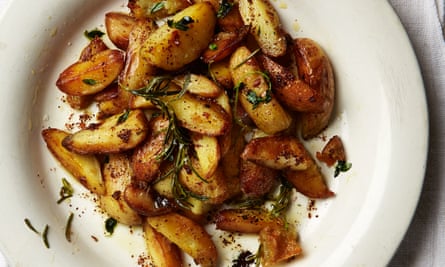
Sumac is an astringent spice that brings a fresh twist to a tried-and-tested classic; it’s widely available in supermarkets. This is a great alternative to roast potatoes, and a lot quicker to make, too. Serves four as a side dish.
150ml olive oil
750g charlotte potatoes (or other waxy new potato-style spud), quartered lengthways
5 garlic cloves, peeled
Salt and black pepper
3 sprigs fresh rosemary
3 sprigs fresh thyme
2 tsp sumac
Heat the oil in a large saute pan on a medium flame, then fry the potatoes, garlic, three-quarters of a teaspoon of salt and a good grind of pepper for 30 minutes, stirring often, until the spuds are golden-brown and soft. Add the herbs, fry for five minutes, until they crisp up, then transfer to a bowl – use a slotted spoon, so you leave most of the oil in the pan. Stir in the sumac and serve hot.
Carrot and pomelo salad
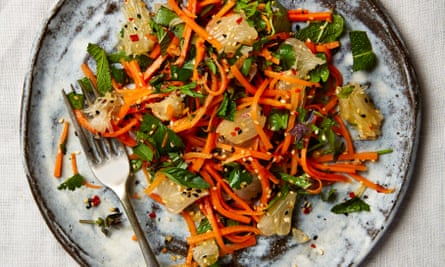
This is a lovely side for grilled seafood or even a bowl of steamed rice. To save a bit of time, coarsely grate the carrots instead of cutting them into julienne strips. Pomelos are similar in flavour to grapefruit, though they’re a bit sweeter; if you can’t find any, use pink grapefruit instead. And if you don’t have black sesame seeds, just use extra white ones instead. Serves four.
3 large carrots, peeled and cut into thin julienne strips
½ pomelo, peeled
1 tbsp lime juice
1 tsp sesame oil
2 tsp sunflower oil
2 tbsp each white and black sesame seeds, toasted (or 4 tbsp white)
20g coriander leaves, roughly chopped
15g mint leaves, roughly shredded
15g Thai basil leaves (or regular basil), roughly shredded
Salt
For the marinade
40g caster sugar
120ml cider vinegar
1 tsp chilli flakes
Put the marinade ingredients in a small saucepan on a high heat, boil for a minute or two, stirring, until the sugar dissolves, then tip into a bowl. Add the carrots, toss and leave for half an hour.
Cut the pomelo into segments, using a sharp knife to remove and discard the pith and membrane. Break the fruit into 2cm pieces and put in a bowl. Drain the carrots, retaining the liquid, and add to the fruit. Add a tablespoon of marinade, the lime juice, oils, sesame seeds, herbs and half a teaspoon of salt, toss and serve.
Rainbow chard with orange, garlic and caraway
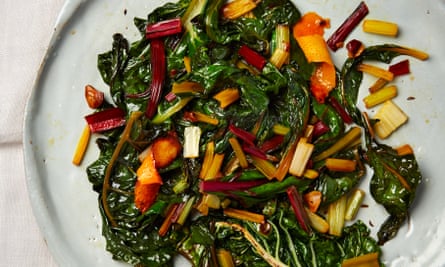
Caraway has an aniseedy/cuminy aroma that I adore, but the taste can be divisive; if you’re not such a fan, reduce the amount, or omit it altogether and use cumin seeds instead. Serves two as a side dish.
2 tbsp olive oil
4 thin strips orange skin (with no bitter white pith)
2 garlic cloves, peeled and sliced thin
½ tsp caraway seeds
400g rainbow chard, washed, stalks and leaves separated, stalks cut into 2cm pieces and the leaves left whole
Salt and black pepper
½ tsp lemon juice
Heat the oil in a large saute pan on a medium-high heat. Add the orange skin, garlic and caraway, and fry for a minute or two, just until the garlic starts to take on a little colour. Add the chard stalks and leaves – to start with, you’ll think it won’t all fit in the pan, but it will do, once it’s stirred in and the leaves wilt. Add a quarter-teaspoon of salt and fry for eight to nine minutes, stirring frequently, until the stalks are soft and the leaves are just starting to brown. Take off the heat, season to taste, and serve hot or at room temperature, with the lemon juice drizzled on top.
Spring greens soup with wild garlic pesto
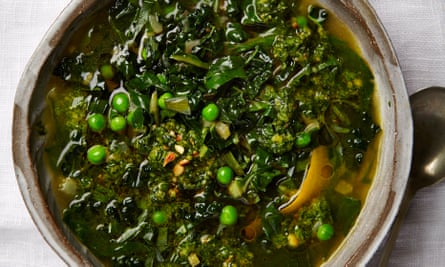
Wild garlic leaves have a sharp, mustardy/garlicky flavour that works well in a spring pesto. They are abundant when in season, but that season is short – it’ll all be gone by the end of May – so don’t worry if you can’t get hold of any: just use a clove of garlic and increase the parsley to 30g. To make this soup dairy-free, simply omit the parmesan from the pesto and increase the amount of salt by a fraction. Serves four.
2 tbsp olive oil, plus 1 tsp to serve
1 onion, peeled and finely chopped
2 sticks celery, finely chopped
4 strips finely shaved lemon skin (with no bitter white pith), plus 2 tsp juice
100g swiss chard, stalks and leaves separated, both finely sliced
Salt and black pepper
200g cavolo nero, stalks removed and discarded, leaves finely sliced
1 litre vegetable stock
100g frozen peas
15g tarragon leaves, roughly chopped
For the pesto
3 tbsp olive oil
20g parsley, roughly chopped
30g wild garlic, roughly chopped (or 1 garlic clove and 10g extra parsley)
50g pine nuts, lightly toasted
30g parmesan, finely grated
10g tarragon
First make the pesto. Put all the ingredients in the small bowl of a food processor with two tablespoons of water and a quarter-teaspoon of salt. Blitz to a rough paste and set aside.
Heat the oil in a large saute pan on a medium-high heat, then fry the onion, celery, lemon skin, chard stalks, a teaspoon of salt and plenty of pepper for 10 minutes, stirring a few times, until caramelised and soft.
Add the chard and cavolo nero leaves, and fry, stirring, for two minutes longer, until the leaves wilt. Pour in the stock and peas, leave on the heat for two minutes or so, until boiling, then stir in the tarragon and lemon juice, and divide between four bowls.
Spoon pesto on top, drizzle with the remaining teaspoon of oil and serve hot.
Roast sweet potatoes with miso glaze

Add a few roughly broken ready-cooked chestnuts, and this would make a fantastic festive dish for Thanksgiving or Christmas. If you do so, mix in the chestnuts with the last third of the glaze, and add for the last five minutes of cooking (rather than 15). Serves four as a side dish.
4 medium sweet potatoes, cut in half lengthways
50g white miso
2 tbsp mirin
1 tsp maple syrup
1 tbsp rice vinegar
½ tsp chilli flakes
1½ tbsp light soy sauce
1½ tsp groundnut oil
Flaked sea salt
Heat the oven to 200C/390F/gas mark 6. Score diagonal incisions on the cut side of the potatoes about 2cm apart and going as deep as you can without cutting all the way through. Repeat in the other direction, to create a diamond pattern.
In a small bowl, whisk the miso, mirin, maple, vinegar, chilli, soy and oil, until smooth. Lay the potato halves cut side up on an oven tray lined with baking paper. Use a pastry brush to spread a third of the glaze over the cut side of the sweet potatoes.
Bake for 15 minutes, then brush with a third more of the glaze. Bake for another 15 minutes, then brush again with the remaining glaze. Return to the oven for a final 15 minutes, until the potatoes are completely soft and caramelised. Sprinkle with sea salt flakes and serve.
Fried broccoli and kale with garlic, cumin and lime
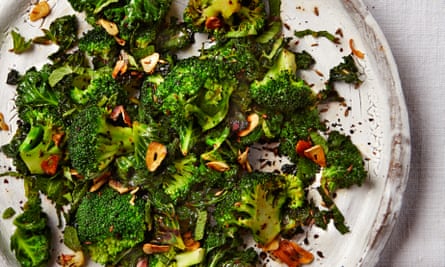
You can blanch the broccoli and kale well ahead of time. Once half-cooked, refreshed and dried, they’re then ready for the final fry before serving. That little bit of prep turns the dish into one that can be on the table in just over five minutes. Serves six, as a side dish.
1 large head broccoli, separated into 3-4cm florets
350g bunch curly kale, tough stems discarded
3 tbsp olive oil
3 garlic cloves, peeled and sliced
½ tsp cumin seeds
2 tsp urfa chilli flakes (or 1 tsp regular chilli flakes)
Salt
10g mint leaves, roughly shredded
1 tbsp lime juice
Bring a large saucepan of salted water to a boil and blanch the broccoli for 90 seconds. Lift out with a slotted spoon, refresh under cold running water and dry well. Drop the kale into the boiling water, blanch for 30 seconds, then drain and refresh. Squeeze out as much water from the kale as you can (I find it easiest to wrap it in a clean tea towel, and squeeze), then set aside.
Heat the oil in a large saute pan on a high flame, then fry the garlic and cumin for about two minutes, stirring a few times, until the garlic turns light golden-brown. Lift out the garlic with a slotted spoon and put on a small plate. Add the kale to the pan (take care, because the moisture in the leaves may cause it to spit to begin with) and fry for three to four minutes, until the leaves start to crisp up.
Add the broccoli, a teaspoon of chilli flakes and a quarter-teaspoon of salt, stir through for a minute, then transfer to a large platter and gently stir through the mint. Drizzle the lime juice over the top and serve with the remaining teaspoon of chilli and the crisp garlic scattered on top.
Roast cauliflower with chorizo and green olives
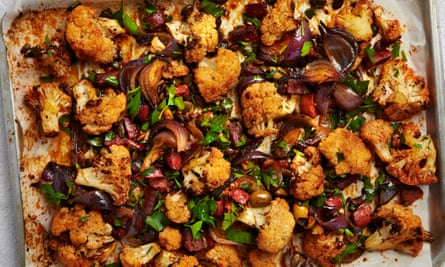
I’ve been using chorizo a lot recently, as a quick way to add intensity to all sorts of vegetable dishes, but this dish also works very well without it; if you do leave it out, increase the paprika to about a tablespoon. Serves four to six, as a side dish.
1 large cauliflower (1kg), trimmed and separated into 3-4cm florets
150g cooking chorizo, skinned and cut into 2cm pieces
2 red onions, peeled and cut into 2cm wedges
30g pitted green olives, torn in half
2 tsp sweet smoked paprika
30g pumpkin seeds
2 garlic cloves, peeled and crushed
3 tbsp olive oil
Flaked sea salt and black pepper
20g parsley leaves, roughly chopped
Heat the oven to 220C/425F/gas mark 7. Put everything bar the parsley in a bowl with a teaspoon and a half of salt and a good grind of pepper. Mix well to combine, then spread out on a 30cm x 40cm baking tray lined with greaseproof paper. Roast for 25-30 minutes, stirring gently halfway through, until the chorizo is cooked and the cauliflower is soft and browned. Leave to cool down for about 10 minutes, stir in the parsley and serve.
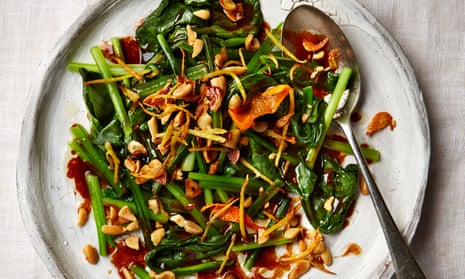
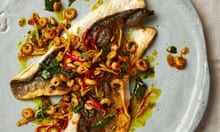


Comments (…)
Sign in or create your Guardian account to join the discussion